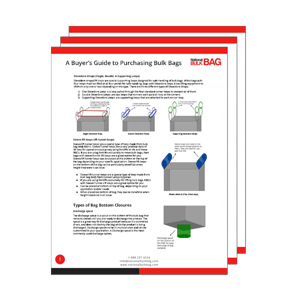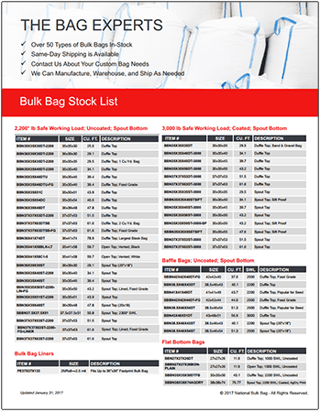FIBCs offer several advantages, including their affordability, versatility, durability and ease of use. One other notable advantage is their ability to be easily moved throughout a facility and loaded onto transport for shipping. They can be stacked, wrapped and even palletized, which is part of the reason they are so popular for such a wide variety of applications.
When transporting and shipping bulk bags, it is important to know the best practices for stacking and securing them, and what factors you should consider then doing so. Let’s explore the best practices for transporting and shipping.
Stacking FIBCs
Stacking is one of the easiest and most efficient methods of preparing them for transportation or shipping. There are several recommended methods for stacking, including:
- Free stacking: The free stacking method involves simply placing one FIBC bag on top of another. When using the free stacking method, take care to lower each bag slowly, and apply pressure to the bottom bags to act as a stable foundation for bags subsequently added to the top of the stack. Free stacking is a great method to use when the materials contained within the bag can withstand the weight of bags stacked atop them.
- Pyramid stacking: The pyramid stacking method is just what it sounds like – stacking bags in a pyramid structure consisting of large tiers at the bottom of the stack and smaller tiers at the top. Pyramid stacking is a preferred method for many applications.
- Supported stacking: Another preferred method for transportation and shipping applications is supported stacking. This method involves placing stacked bags in even rows against a wall, such as the wall of a truck or trailer. Supported stacking helps to limit material shifting during transport.
When choosing a method of stacking your bag for transportation or shipping, carefully consider all factors and select the method that offers the optimal protection for the materials inside each bag while ensuring maximum safety for all personnel involved in both ends of the process.
Palletizing FIBCs
It is important to note that while stacking bags for transport is a sound strategy, it isn’t always a viable option, especially when putting large quantities of bags into a single truck. When stacking isn’t an option, consider palletizing your bags for transportation or shipping. Palletizing is a common technique because it provides added security and makes loading and unloading much easier.
Securing bags to pallets can be tricky, however there are two methods that we see used with great success, including:
- Pallet wrappers: Using pallet wrappers or stretch wrap to secure bags to a pallet is an easy and effective way to prevent shifting during transport. This method is easy, secure and affordable, and can even be automated in many cases.
- Bands: Another common method of securing bags to pallets is to use metal or plastic banding. This approach creates a secure load but does involve more labor and can be more expensive than pallet wrapping.
However you choose to secure your bulk bags to pallets, be sure to take the time to do so carefully and securely. Done properly, the palletizing allows for more secure stacking and makes it easier to fit large quantities of bags in semi-trucks for transport.
Talk to Your Distributor for Additional Advice
Because bulk bag are flexible, users can fit many more in a single storage space in the warehouse – up to 200 flexible intermediate bulk containers on one pallet versus 50 empty gaylords in the same amount of space.
National Bulk Bag is here to help you develop the best methods of transporting, shipping and storing your bags. Whether you simply need advice or are searching for a new solution for your facility, we can help. In addition to our knowledge of the FIBC industry, we can also provide pallet machines and stretch wrap supplies perfect for this application through our parent company, Rapid Packaging.
Reach out today to discuss your specific transportation and shipping needs.
Thanks for reading!
It's our mission to make your bag buying experience easy, informative, and enjoyable. We also want to share our knowledge with you, so you can make the best purchasing decision for the company you represent. Our Buyer's Guide to Purchasing Bulk Bags includes critical information ranging from types of bags to important safety information about handling and transportation.

Download the guide by clicking below. By downloading, you'll learn all about:
- Types of bags
- Coated vs. uncoated
- Liners
- Bags with baffles
- Types of lift loops
- 5:1 & 6:1 safety guidelines
- Much more!
Click the button below to download our comprehensive buyer's guide.






